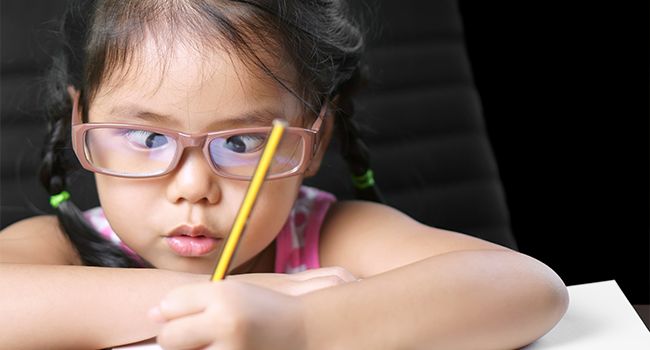
Eye problems are common in newborn babies and kids. But if these are not treated at the right time, they may cause severe visual impairments in the future.
Lazy eye in kids or amblyopia in kids is one of the most common eye problems, where the brain to eye function is weakened, and the affected eye does not follow the brain’s instructions. This can cause the eye to move away from the expected visual path.
What does the term Lazy eye in Kids mean?
Lazy eye is a prevalent vision condition in babies and toddlers. Lazy eye mainly occurs because of an impaired brain to eye function, which causes the affected eye not to follow the brain’s instructions. This leads to misalignment within the eyes, with the affected eye wandering away from the normal eye.
When a child is born, up to 8 years of age, the brain’s ability to send important signals to the eyes is still developing. Within this period, if anything causes the child’s vision to blur, it can block the visual signals sent by the brain. This results in an impaired brain-to-eye connection that may cause sudden lazy eyes in the child. The weaker eye receives fewer brain signals and cannot function as the normal eye, leading to vision problems.
Causes of a Lazy Eye in Kids
There are a number of reasons that can cause the blurring in your child’s vision or cause the eyes to turn or roll, eventually leading to a lazy eye. Let’s see some of the common lazy eye causes.
1. Weak eye muscles
When eye muscles are weak, they lose the ability to hold the eye in the correct position. Hence, causing the eye to cross and turn, which leads to misalignment between the two eyes and eventually affects the vision.
2. Refractive changes
Refractive changes in vision like farsightedness or nearsightedness that cause significant changes in the vision of both eyes can also lead to lazy eyes in kids.
These refractive changes are often corrected using corrective glasses or contact lenses.
3. Deprivation amblyopia
Deprivation amblyopia occurs due to the clouding of vision in infants as a result of cataracts. This results in blurring of vision that leads to amblyopia or lazy eye in kids.
4. Anisometropia or different vision strengths
Sometimes the visual strength of one eye is more than the other. This is called anisometropia, and it causes the eye with lower visual power to see blurry. The brain tends to ignore the blurry eye hence causing it to drift away, leading to a lazy eye.
Other than the above causes, genetics, premature birth and delay in developmental milestones can also cause a lazy eye in kids.
What is the Treatment of Lazy Eye?
The treatment of lazy eye widely involves treating the lazy eye causes.
1. Corrective Glasses
Glasses are an option for the treatment of lazy eyes in toddlers if the lazy eye is affected either by refractive changes or anisometropia. With corrective glasses, the refractive changes are corrected, and a clearer vision is sent to the brain.
2. Using an eye patch
Using an eye patch over the unaffected eye is an excellent way of treating lazy eyes in kids. It forces the brain to focus on the weak eye and is also a great exercise for the weak eye muscles.
This can be done with both with or without glasses. In kids who use glasses, a special cloth patch is prescribed that can be easily worn over the glass lens. However, in those who do not use glasses, a patch that sticks to the eye can be used.
3. Exercises
Several eye exercises help strengthen the eye muscles and improve the vision when done right and in combination with other treatments.
4. Atropine eye drops
Atropine eye drops are only used in cases where children are not willing to wear the eye patch. These drops blur out the vision in the strong eye temporarily and have the same effect as the eyepatch.
5. Surgery
Surgery is the last resort when no other treatment works. Surgery for lazy eyes involves tightening or loosening the muscles that cause the misalignment in the eyes.
The problem can be severe and lead to severe visual impairments and even complete blindness if not treated on time. Therefore, early lazy eye diagnosis and treatment is very important.
Why choose Centre for Sight?
At Centre for Sight, there is no age bar for the patients. We treat patients of all ages, from newborn babies to geriatric patients.
There is a separate team for paediatric eye care at Centre for Sight to ensure your child gets the best eye care. Our innovative technologies and highly effective diagnostic centres can ensure that the right treatment is given at the right time!
Article: Lazy Eye in Kids: Should you be worried?
Author: CFS Editorial Team | Jun 03 2021 | UPDATED 04:40 IST
*The views expressed here are solely those of the author in his private capacity and do not in any way represent the views of Centre for Sight.
